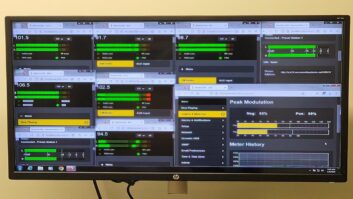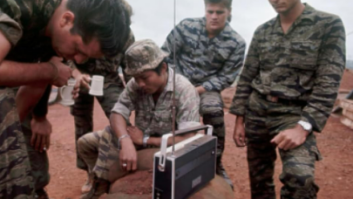https://www.youtube.com/watch?v=zWoLeSEOQGo
KABUL, Afghanistan — The telecommunications sector in Afghanistan is vibrant with four main telecom operators providing cellular telephone coverage to even the most remote corners of the mountainous country.
Some 8.45 million mobile telephones are in use in the country, compared to just 460,000 landlines, and the Salam Watandar radio network is using that same network to solve connection problems for its affiliates.
The Internews Network, a California-based nonprofit NGO that seeks to develop independent local media around the globe, launched Salam Watandar (“Hello, Countryman”) in Kabul in 2004, providing news, current affairs, educational and cultural programming in the Dari and Pashtu languages. Its programs are carried by 41 local independent and community stations in 27 of Afghanistan’s 34 provinces.
“In the past, we had to rely on a one-way free-to-air channel on Eutelsat Hot Bird 6 to get our programming to our affiliates, with no real way for them to have immediate two-way communication with us or with partner network stations,” said Charmaine Anderson, Internews country director for Afghanistan.
“But now that a local Afghan wireless company is providing us with 2 Mbps of bandwidth on their cellular telephone backbone, we have two-way communications with all of our affiliates. Not only does this make it easier to feed network programming, but now we can share content and communications in real time.”
COMMUNICATE VIA CELLULAR
The first thing to understand about Salam Watandar network communications is that they are transported using “Radio over IP,” or RoIP. In other words, all audio is converted to digital, IP-based files, so that they can be efficiently transmitted over the cellular telephone backbone.

Digigram IQOYA codecs are used to encode audio for distribution via the RoIP network. “We are running some very low demand, creative AAC audio algorithms that allow us to send 32 kHz mono audio in just 45 kHz to 50 kHz of bandwidth,” said Jeff Bemrose, Internews senior technical advisor. “This means that we can support up to 24 channels at a time over the network.”
The process starts at the Salam Watandar five-studio complex in suburban Kabul. The programs made there are packaged using Digigram IQOYA *Serv/Link audio codecs, carried to the various tower gateways via E1 lines using Orion Telecom VCL-4 Ethernet-over-E1 converters, and then sent via a 5.8 GHz Ubiquiti Bullet IP radio link from the Salam Watandar network operation center to a reception site at the wireless carrier. (See Figure 1.)
From here, the files are distributed in real-time to affiliates, who are also equipped with Ubiquiti Bullets and IQOYA *Link boxes. Because the network is IP-based, the Kabul hub can send down other programs at the same time and support two-way voice calls. It can also receive content coming in from the affiliates.
(click thumbnail)
Figure 1: The RoIP Broadcast Distribution Network Even in the most remote of areas, these stations tend to be computer-based, two studio (one on-air, one production) facilities whose reporters rely on digital audio recorders, desktop audio editing and cellphones.
“The key to the operation is the Ubiquiti Bullet that connects from the board to our 24 channel cellular network. We also use Digigram IQOYA to encode audio for sending from the station to our Kabul NOC,” said Bemrose.
Within the NOC, Wheatnet-IP audio-over-IP technology is used to manage the flow of audio.
“This is a relatively new form of technology that makes our network architecture possible. In doing so, it provides a cost-effective, practical link that can’t be duplicated. After all, in Afghanistan a single 4 Mbps Internet line costs $6,000 a month,” he said.
BACKBONE ACCESS
“I can’t imagine a cellular network in North America providing the kind of backbone access we have here,” he added. “The economics would just work against it. But for a developing country like Afghanistan where cellular is really the only viable two-way communications medium, our approach makes good sense, and is worth consideration by other broadcasters.”


Charmaine Anderson and Jeff Bemrose of Internews Internews began testing the RoIP cellular telephone backbone in April 2010, and it is changing the way the network does business. No longer are affiliates passive receivers of information: They are now active members who contribute to overall programming. This two-way reach will vastly improve Salam Watandar’s ability to cover breaking news, and make the service more relevant to listeners across Afghanistan.
In the future, Salam Watandar plans to create an archive of stored programs that its affiliates can access and broadcast on demand; again over the cellular backbone.
“We are also considering ways to move streaming video in this manner. Although the video quality would not be as good as broadcast, the ability to get any video in and out of areas would be of profound value,” said Bemrose.
“Using RoIP over cellular has revolutionized the way Internews works in Afghanistan,” Anderson concludes. “It will be exciting to witness the community connections the various stations linked via RoIP will make together outside their current signal footprints.”












